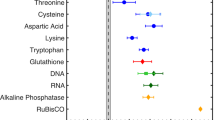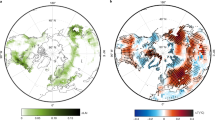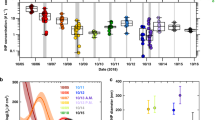Abstract
INITIATION of precipitation over much of the Earth's surface is believed to be intimately related to the development of ice in supercooled clouds. The source, composition and number of small particles (ice nuclei) initiating freezing events in natural clouds are poorly understood. These particles represent a very small fraction of the total aerosol in the atmosphere. The material most frequently held to represent the majority of ice nuclei are clays, especially kaolin.
This is a preview of subscription content, access via your institution
Access options
Subscribe to this journal
Receive 51 print issues and online access
$199.00 per year
only $3.90 per issue
Buy this article
- Purchase on Springer Link
- Instant access to full article PDF
Prices may be subject to local taxes which are calculated during checkout
Similar content being viewed by others
References
Schnell, R. ., and Vali, G., Nature, 236, 163 (1972).
Schnell, R. C., Technical Report AR102, Department of Atmospheric Resources (Univ. Wyoming, Laramie, 1972).
Vali, G., J. atmos. Sci., 28, 402 (1971).
Köppen-Geiger, Klima der Erde (Map) (Justus Perthes, Darmstadt, 1954).
Fresh, R. W., Technical Report AR106, Department of Atmospheric Resources (Univ. Wyoming, Laramie, 1973).
Bigg, E., and Stevenson, C., J. Rech. Atmos., 4, 42 (1970).
Author information
Authors and Affiliations
Rights and permissions
About this article
Cite this article
SCHNELL, R., VALI, G. World-wide Source of Leaf-derived Freezing Nuclei. Nature 246, 212–213 (1973). https://doi.org/10.1038/246212a0
Received:
Revised:
Issue Date:
DOI: https://doi.org/10.1038/246212a0
This article is cited by
-
Glacially sourced dust as a potentially significant source of ice nucleating particles
Nature Geoscience (2019)
-
Forests, atmospheric water and an uncertain future: the new biology of the global water cycle
Forest Ecosystems (2018)
-
Contributions of biogenic material to the atmospheric ice-nucleating particle population in North Western Europe
Scientific Reports (2018)
-
The study of atmospheric ice-nucleating particles via microfluidically generated droplets
Microfluidics and Nanofluidics (2018)
-
The relevance of nanoscale biological fragments for ice nucleation in clouds
Scientific Reports (2015)
Comments
By submitting a comment you agree to abide by our Terms and Community Guidelines. If you find something abusive or that does not comply with our terms or guidelines please flag it as inappropriate.



